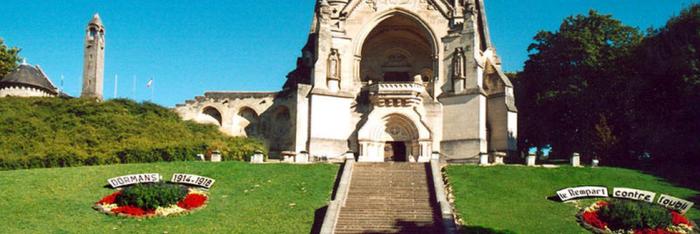
Memorial to the Battles of the Marne. Source : GNU Free Documentation License
Built between 1921 and 1931, the Dormans Memorial commemorates the victories won in the Marne between 1914 and 1918.
The Memorial is situated on the left bank of the Marne on a hill overlooking the river and the town of Dormans. When the plan to erect a large monument to remember all of the battles in Marne was confirmed, this site was chosen by Marshal Foch as a place that represented both battles. The building was made possible thanks to an association founded by Madame de la Rochefoucauld in 1919, overseen by the Cardinal of Reims and the Bishop of Châlons. A vast park with a chateau was purchased, and the first brick was laid on 18 July 1920. The building work, which took 10 years from 1921 to 1931, was funded by numerous donations, in particular those collected by the ‘national subscription’ in 1929 dubbed "four monuments day” (the association which became a charity, was recognised as a public interest organisation by presidential decree on 20 May 1932).
The impressive ensemble was designed by architects Marcel and Closson. A monumental staircase leads to a large square with a sundial and a viewpoint indicator that shows the names of the villages in the Marne Valley where the Battle of 1918 was fought. The square itself leads to a crypt that is overlooked by the church that boasts a bell tower and two ridge towers.
The inside of the chapel is entirely dedicated to the glory of the “soldiers, the army and the fatherland".
The stained-glass window in the choir represents Christ welcoming a soldier to symbolise all those who died during the Great War, presented to him by Joan of Arc and St Michael. On each side, angels intercede in his favour.
The stained-glass windows at the sides of the transept (by the renowned Lorin firm in Chartres) represent the patron saints of the different branches of the army.
The four columns standing on the crypt’s vaulted bases are decorated with sculptures depicting the four great invasions of France by the Huns, the Arabs, the English and the Germans, which were all contained (the Catalunian Plains in 451, Poitiers in 732, Orleans in 1429 and Dormans 1914-1918).
The 52-metre tower houses several bells, the largest weighing 304 kg. Beside the chapel is a cloister. Rather austere in appearance with its pointed arch, from the side it is attached to a funerary building housing the ossuary, close to a lantern tower for the dead. At its entrance, a medallion features the effigies of marshals Foch and Joffree, the two victors of the battles of the Marne, while the names of all the soldiers who fought in the battles are engraved in the wall plaques.
Inside the ossuary, the mortal remains of 1,332 French soldiers who fell between 1914 and 1918 are held in 130 coffins; only 11 of these men were identified. The funerary chamber also holds two urns: the first one contains earth taken from the cemetery in Italy where soldiers of the Free French Forces killed during the battles in 1943-1944 in Monte Cassino are buried; the other holds the ashes of deportees returned from Dachau in 1948.
Every year since 1993, during the Armistice commemorations, an official ceremony is held in the ossuary where a wreath given by the French President is laid by a delegate Senior Officer from the Elysée Palace.
Opening times
From 1 April to 11 November every day from 2-6 pm and Sundays from 10 am to 12 pm and 2-6 pm.
Contact
Dormans Tourist Information Office, Château de Dormans - 51700 DORMANS
Tel: +33 (0)3 26 53 35 86
Memorial secretariat: +33 (0)3 26 57 77 87
Memorial: +33 (0)3 26 59 14 18
Site du 90e anniversaire des batailles de la Marne
Office de tourisme de Dormans
Source: MINDEF/SGA/DMPA - Vincent Konsler